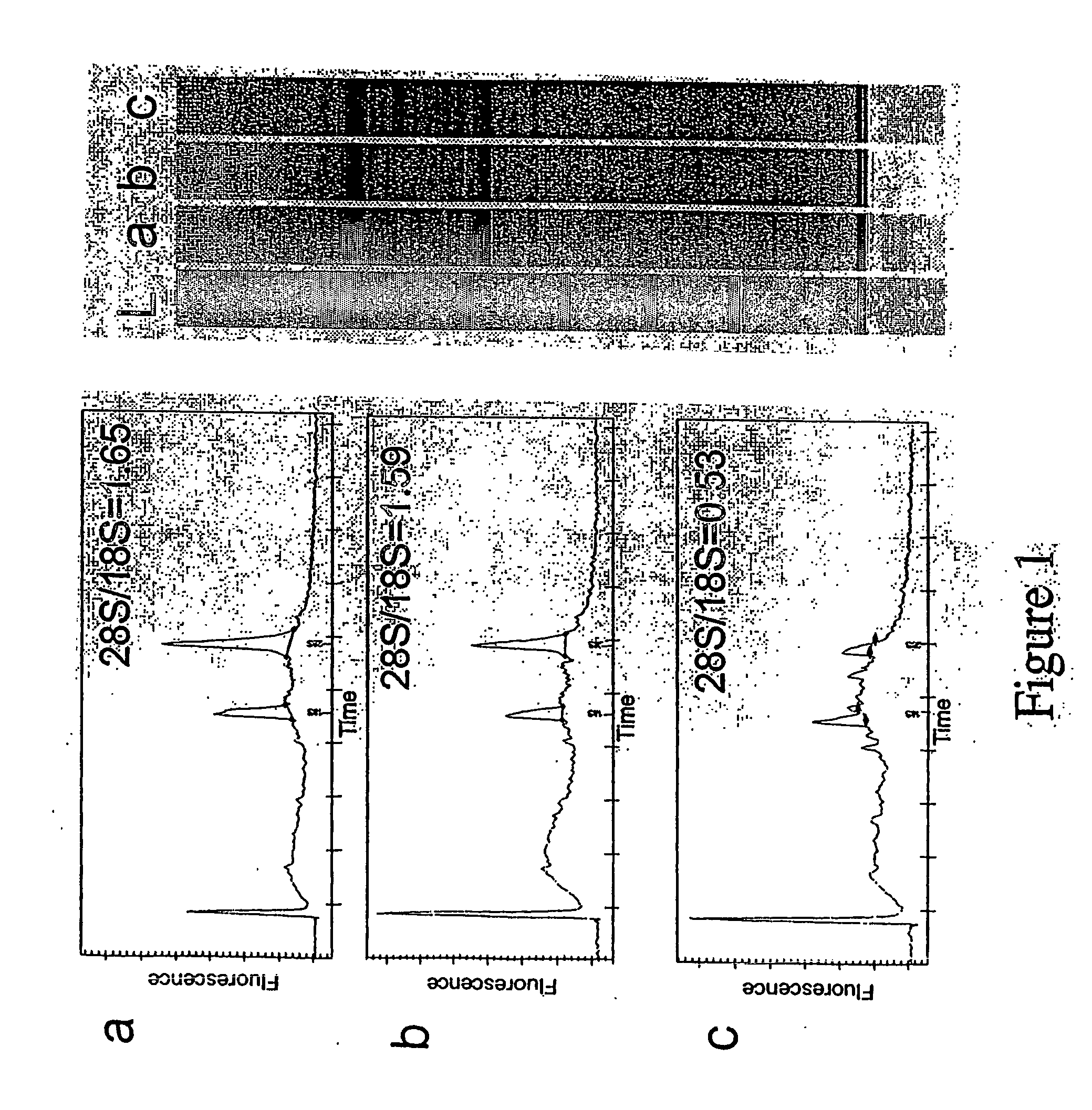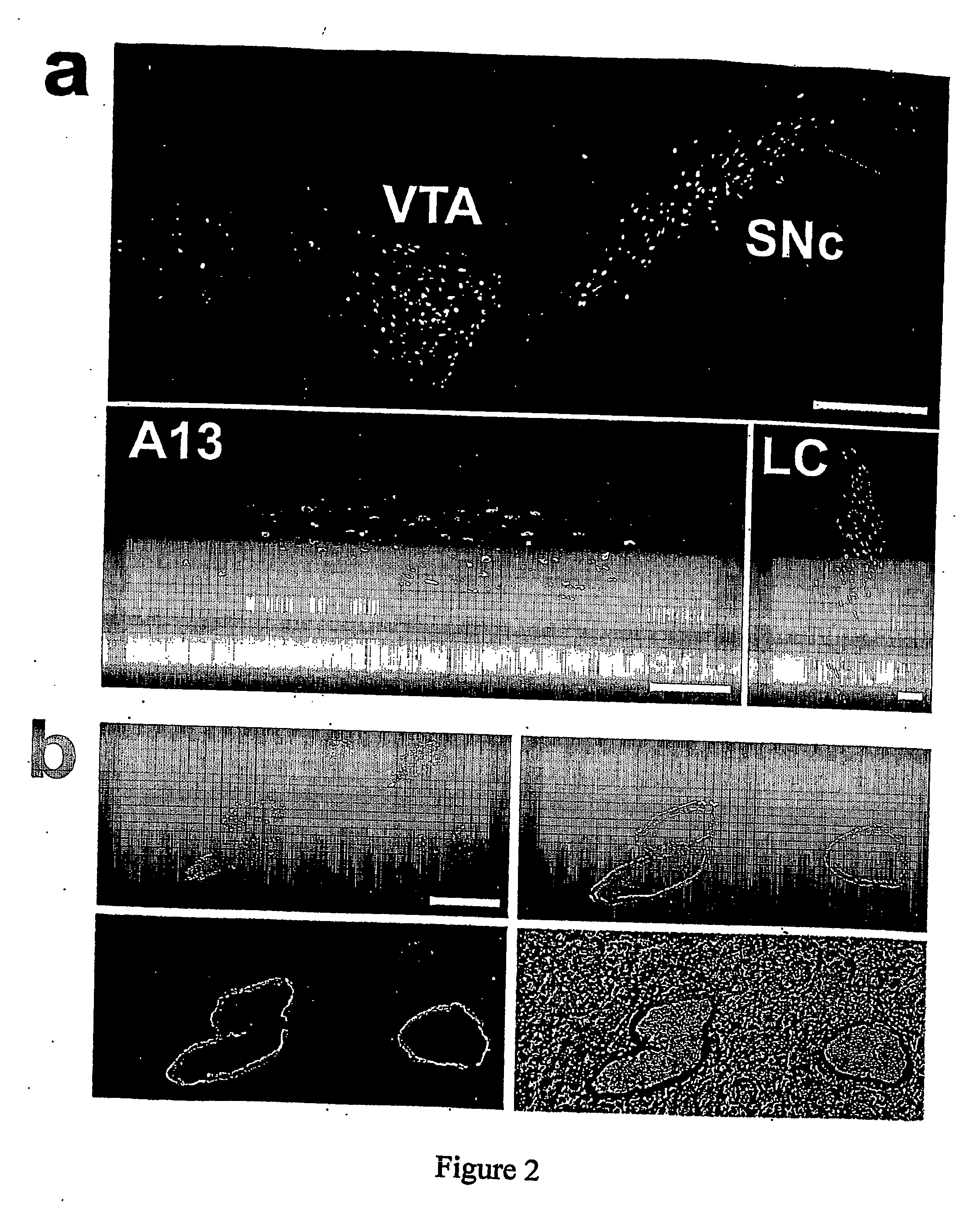Methods For Idendifying Drug Targets And Modulators Of Neurons and Compositions Comprising The Same
a technology of modulators and drug targets, applied in the field of neuroscience, can solve problems such as rhythmic tremors, inability to initiate and complete routine movements, and motor function impairment, and achieve the effect of maximizing isolation and/or recovery
- Summary
- Abstract
- Description
- Claims
- Application Information
AI Technical Summary
Benefits of technology
Problems solved by technology
Method used
Image
Examples
example 1
Drug Targets Identified In Rat Brain Tissue
Tissue Preparation and Immunohistochemistry
[0130] Standard histochemistry protocols result in severely degraded RNA that is not suitable for RNA amplification and microarray analysis. Incubation of tissue sections in buffered aqueous solutions results in nearly complete degradation after only several minutes. In order to allow microarray analysis of immunostained single cells a staining protocol that results in only minimal degradation of RNA was developed. The method involves a rapid 4-minute staining protocol that allows antigen detection with high sensitivity without severely compromising RNA integrity (FIGS. 1 and 2).
[0131] Rat brains are dissected and immediately and allow to freeze slowly on dry ice. Frozen brain specimen are stored at −80° C. until sectioning. 12 μm serial sections are cut in the cryostat and are mounted on pre-processed polyethylene naphthalene membrane slides (see below). The sections are fixed immediately in 1...
example 2
Drug Targets Identified In Human Brain Tissue
Tissue
[0138] The Stanford University Medical School Brain Bank provides the brain samples under NIH and Stanford University guidelines. These samples are frozen in liquid nitrogen immediately after dissection. To evaluate the RNA quality of a sample we extract the RNA of a single cyrosection and analyze it on the Agilent bioananlyzer (FIG. 3). In general the degree of preservation of RNA in post mortem human brain samples is often poor (as assessed by the presence of the ribosomal 18S and 28S ribosomal RNA peaks) and does not directly correlate with the post mortem delay. Therefore only a small subset of autopsy material is suited for single cell microarray analysis experiments (FIG. 3).
[0139] Dopaminergic neurons in the substantia nigra and noradrenergic neurons in the locus coeruleus were identified by their content of neuromelanin pigmentation (FIG. 4). All experimental steps were carried out as described as described in Example 1 ...
example 3
Genes That Define the Four Major Classes of Dopaminergic (DA) and Noradrenergic (NA) Neurons
Material and Method
Tissue Preparation and Immunohistochemistry
[0143] Brains of adult (7-9 month) female Sprague Dawley rats were dissected and immediately frozen on dry ice. 12 lm cryosections were mounted on polyethylene naphthalene membrane slides pretreated with 0.1% poly-L-lysine for 5 min followed by 30 min of UV irradiation. The sections were fixed immediately in 100% ethanol for 30 s followed by 3 s in acetone and air dried. After rehydration in PBS, pH7.0 for 5 s, the sections were stained for 2 min in PBS, pH7.0; containing 100 μg / ml anti tyrosine hydroxylase antibody (clone TH-16, Sigma) that had been labeled with the Alexa Fluor 488 monoclonal antibody labeling kit (Molecular Probes) according to manufacturer's instructions. Rehydration and staining were performed in the presence of 1 U / ul RNAse inhibitor (Roche, Germany). The sections were washed twice in PBS, for 5 s, dehydr...
PUM
| Property | Measurement | Unit |
|---|---|---|
| Level | aaaaa | aaaaa |
Abstract
Description
Claims
Application Information
 Login to View More
Login to View More - R&D
- Intellectual Property
- Life Sciences
- Materials
- Tech Scout
- Unparalleled Data Quality
- Higher Quality Content
- 60% Fewer Hallucinations
Browse by: Latest US Patents, China's latest patents, Technical Efficacy Thesaurus, Application Domain, Technology Topic, Popular Technical Reports.
© 2025 PatSnap. All rights reserved.Legal|Privacy policy|Modern Slavery Act Transparency Statement|Sitemap|About US| Contact US: help@patsnap.com



